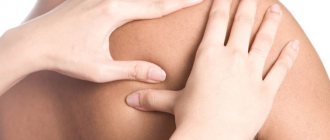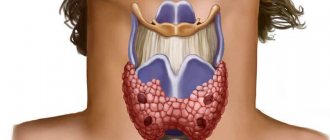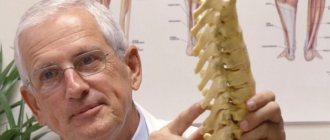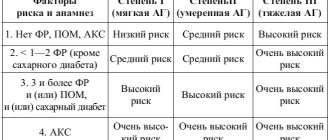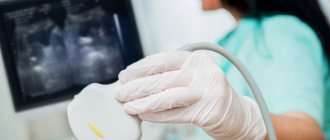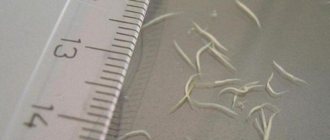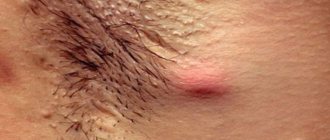Osteochondrosis of the chest is not a common disease and physically tangible manifestations of the disease can begin in the later stages. This is due to the specifics of the thoracic spine - it is inactive, but the load on it is much lower than on the lumbar spine. That is why pathological processes in the thoracic spine are rare, although not extraordinary. Scoliosis or problems with posture can accelerate their course.
However, diagnosis too late can lead to complications in the chest organs, particularly the heart.
Provoking factors
Pain with thoracic osteochondrosis indicates ongoing changes in all tissues and organs of the damaged area.
Pain in thoracic osteochondrosis can manifest itself under the influence of many factors, among which are the following:
- excess weight;
- ongoing infectious diseases;
- metabolic disorder;
- prolonged stay in one position.
The discs located between the vertebrae become deformed. Bone growths also occur.
All processes occurring in the body provoke compression of nerve branches. This results in significant pain. In addition, muscle spasms may form and they become weakened.
Pain with thoracic osteochondrosis indicates ongoing changes in all tissues and organs of the damaged area. Because of this, an inflammatory process occurs, which can be triggered by disruption of the functioning of some organs.
Symptoms
To determine the course of the disease, it is very important to know how thoracic osteochondrosis hurts at various stages. At the initial stage, pain occurs very rarely and is not very intense. As the pathology progresses, pain appears much more often and can be regular.
A much later stage is characterized by acute and chronic pain throughout the entire period, as well as a feeling of stiffness in the back. Not only the sternum begins to hurt, but also the limbs, as the nerve endings are pinched. Patients may experience numbness and tingling.
Often, pain occurs in the sternum, and increases significantly with bending of the body and awkward movements.
With osteochondrosis occurring in the thoracic region, the following symptoms occur:
- pain in the sternum with a feeling of squeezing;
- heartache;
- pain in the stomach and intestines.
Often the pathology has signs of other diseases, which is why it is quite difficult to recognize the pathology and for this purpose a comprehensive diagnosis is carried out.
Features of osteochondrosis of the thoracic spine
The thoracic region contains twelve vertebrae that connect to the ribs. In addition, the ribs are attached to the sternum. Thanks to this structure, a strong frame is formed in which the organs of the chest are located.
High loads do not have a negative effect on the thoracic vertebrae, and therefore osteochondrosis of this area is diagnosed much less frequently. Since this segment has a convex shape, uneven load distribution is observed. The anterior and lateral areas suffer the most, which provokes the appearance of osteophytes in these places. Growths rarely appear on the posterior surface.
Thoracic osteochondrosis provokes changes in the structure of the intervertebral discs. The pathology is caused by drying out and loss of shock-absorbing properties of the core, while the fibrous ring becomes much thinner and cracks can form on it.
It is worth considering that there are no nerve endings in this area. In addition, there are no spinal cord membranes, and therefore osteochondrosis often does not cause discomfort. The occurrence of this syndrome can be explained by disorders in the joints connecting the vertebrae and ribs. In addition to discomfort, problems often arise in the functioning of internal organs.
Osteochondrosis provokes the following disorders:
- neurological – problems with nerve patency;
- static – changing the shape of the spine;
- vascular – disruption of the functioning of the nerve plexus and vascular spasms.
Degrees
Pathology can have several degrees of development, which depend on the severity of the destruction:
- 1st degree. The elasticity and height of the discs decrease, and protrusions called protrusions often form.
- 2nd degree. The height of the discs continues to decrease. In addition, they also lose their elasticity. The thoracic region loses stability, which only complicates the situation. A dangerous complication of the process is the appearance of cracks in the fibrous ring, which can lead to the formation of a hernia. This degree is characterized by the occurrence of pain and neurological manifestations.
- 3rd degree. A hernia forms, which leads to symptoms of osteochondrosis. All manifestations depend on the size and location of the hernia.
- 4th degree. The disc loses its shock-absorbing characteristics, and the vertebrae become closer together. As a result of such processes, the spine loses mobility, and nerves and blood vessels can be pinched. In addition, bone tissue is often destroyed.
Types of pain
What kind of pain occurs with osteochondrosis of the sternum and what determines its occurrence - these and many other questions worry patients. Often, pain occurs in the sternum, and increases significantly with bending of the body and awkward movements.
Sometimes with osteochondrosis the chest hurts and the pain can be quite sharp, so many people confuse it with heart disease. This condition is mainly observed in women.
Soreness also manifests itself in the intercostal space, this is especially noticeable during breathing, so all the signs of shortness of breath characteristic of the ongoing pathology are observed. This condition occurs due to compression of nerve branches.
Pain with osteochondrosis of the thoracic region can also radiate to the liver, stomach or intestines. Sometimes the painful sensations are girdling in nature, which is why many people mistake this for an attack of pancreatitis. It is worth noting that in women all the signs appear much more acutely.
All types of pain can be divided into several syndromes, in particular such as:
- dorsalgia;
- dorsago;
- cardiac syndrome;
- pulmonary syndrome.
Dorsalgia is characterized by the fact that it occurs over a long period of time and is formed due to the patient’s prolonged immobile state. Basically, attacks are observed or intensified at night, when the person is motionless.
With dorsago, the pain is mainly cutting and stabbing, and it is formed mainly by awkward turns or sharp bends of the body. In addition, cardiac syndrome is observed, in which pain begins to radiate to the left side of the sternum, provoking an attack of angina pectoris.
Pulmonary syndrome causes congestion in the lungs, however, unlike inflammation, this condition always occurs with elevated temperature.
Degrees of the disease and its diagnosis
Thoracic osteochondrosis has 4 periods of development and is accordingly divided into 4 degrees.
First degree. It can be asymptomatic (a feature of this form of the disease), but can also be characterized by pain in the thoracic spine, constant or sporadic lumbago, as well as pain in the heart and convulsive contractions of the chest or back muscles.- Second degree. It is characterized by abnormal intervertebral mobility due to the onset of destruction of the intervertebral disc. It manifests itself in frequent subluxations of the thoracic vertebrae, pain that intensifies with movement and severe discomfort in a static posture.
- Third degree. It means a rupture of the annulus fibrosus - a ring of connective tissue that forms the basis of the intervertebral disc. In this case, a hernia is formed, which entails serious consequences in the form of limited mobility of the thoracic spine, pathological changes in the shape of the spinal column and, as a result, severe continuous pain. The third degree can also be represented by the opposite phenomenon - insufficient fixation of the spinal column, which entails continuous tension in the muscles that support it.
- The fourth, extreme degree of the degenerative process. This means that fibrosis has begun in the affected area - various tissues of the spine and surrounding muscles, including bone and cartilage, have begun to be replaced by connective tissue. In particularly advanced cases, even ligaments are subject to fibrosis. At this stage, treatment of the disease is almost impossible, because part of the spinal column ceased to exist.
Note! The main methods for diagnosing thoracic osteochondrosis are radiography and computed tomography.
They allow you to see changes in the shape of the vertebral body, the contours of the intervertebral disc, detect changes in the height of this disc and detect hernias, if any.
If you have been diagnosed with osteochondrosis of the chest, then in order to avoid worsening the situation and accelerated development of this pathology, you should adhere to a number of simple rules:
- avoid lifting heavy objects;
- during sedentary work, do a light warm-up and stretching of the pectoral and back muscles every two hours, do not allow them to “stagnate”;
- if possible, take a horizontal position for half an hour or an hour once a day;
- go swimming or exercise therapy.
The most important thing is to strictly follow all the doctor’s instructions. Self-medication for this disease, as well as negligent attitude towards one’s health, is categorically unacceptable. Remember: at the fourth and sometimes third stage of development, when fibrosis begins, it will be too late to treat the disease.
Pain in women and children
Pain during thoracic osteochondrosis in women is observed much more often and manifests itself more intensely. This pathology develops mainly at the age of 45-50 years due to a decrease in the level of estrogen in the body, which results in destructive processes occurring in the spine.
In children, such a disease is observed quite rarely, however, a violation of the integrity of the vertebrae can occur with certain hereditary pathologies that occur against the background of the main symptoms. Due to severe pain, the child becomes very nervous, often refuses food and has sleep disturbances.
Prevention
The best way to prevent it is moderate physical activity and reducing body weight if it is excess. You should lead an active lifestyle, give up bad habits, and normalize your diet. Swimming, light jogging, and walking in the fresh air give a good effect. When working sedentarily, you need to monitor your posture and periodically warm up during the working day. The correct selection of furniture plays an important role - the back of the chair should be comfortable and provide good back support.
During pregnancy, it is recommended to wear support belts and bandages. It is better to sleep on an orthopedic mattress of medium hardness - this way your back will take the correct anatomical position while sleeping. Shoes should be comfortable, especially if a person walks a lot. You can use orthopedic insoles. By following these recommendations, you can maintain the health of your back and the body as a whole for a long time.
Treatment
To improve the patient’s well-being, it is imperative to relieve pain due to osteochondrosis, and for this the doctor prescribes a pain reliever. In particular, nonsteroidal anti-inflammatory drugs, analgesics, and muscle relaxants have such characteristics. For intense pain, novocaine blockades are prescribed.
Good results can also be obtained by using drugs in tablet form, as well as ointments and gels that relieve pain and inflammation. To quickly eliminate all symptoms, additional use of traditional medicine is also recommended. There are many different recipes available. They help relieve acute pain, improve blood circulation and metabolic processes in the intervertebral discs.
In case of sudden and prolonged attacks of pain, additional wearing of a support corset is recommended. This will reduce the stress placed on the vertebrae and relieve pain.
Important! All medications must be prescribed by a doctor, since incorrectly administered therapy can cause side effects.
To quickly eliminate pain, it is imperative to initially treat the underlying disease. Elimination of pain is possible only after blocking muscle spasms, reducing pressure on nerve endings, and relieving inflammation.



